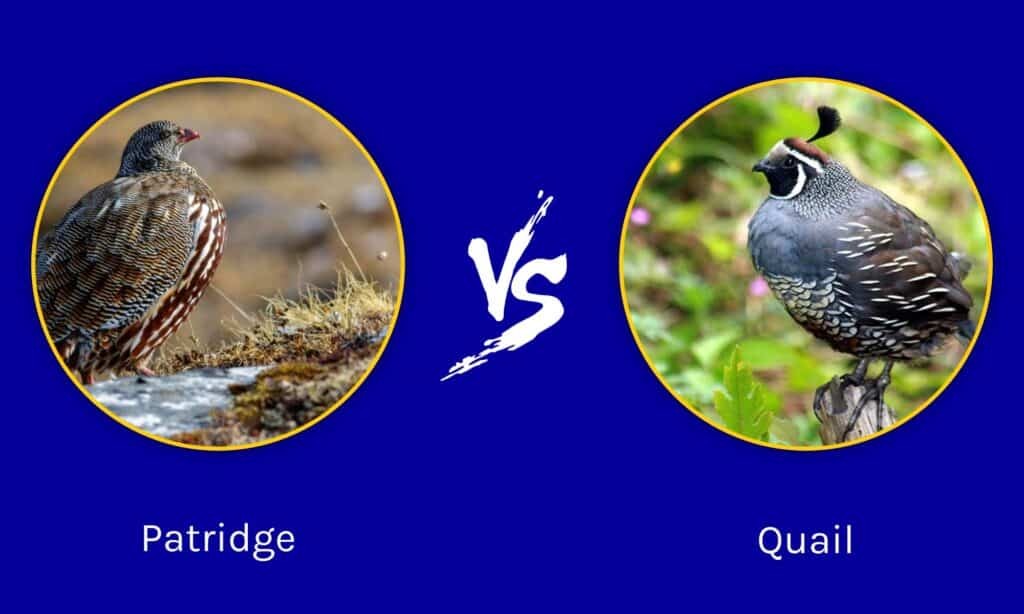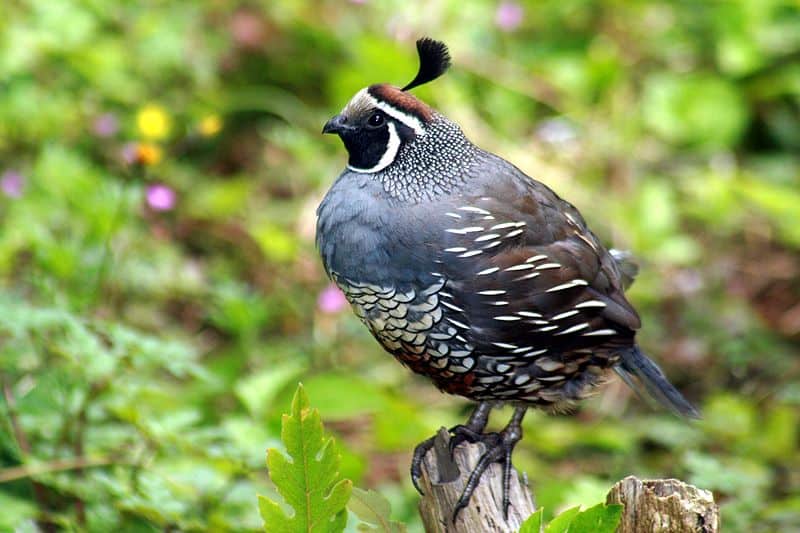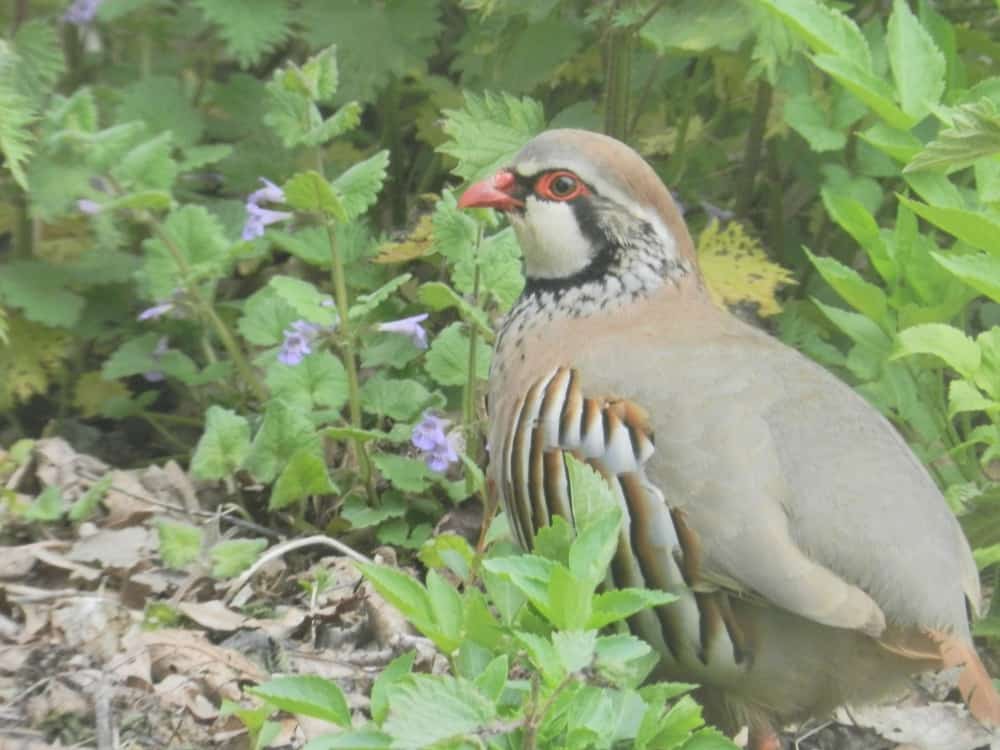Quail and partridge belong to the Phasianidae family, along with pheasants and peacocks. Quail are native to both the Eastern and Western hemispheres. Arid and semi-arid regions, deserts, and agricultural land all support quail and partridge populations. Many hunters target these birds. Quail and partridge have plump bodies and four-toed feet. So, what differentiates these two birds? In this article, we will explore 8 key differences between the partridge and the quail.
Partridge vs Quail: A Comparison

| Partridge | Quail | |
|---|---|---|
| Size | Up to 12 in Long; Up to 0.75 lbs. | 1 lb; 6-7in in Tall |
| Colors | Males have Black Faces with white stripes, Females are Mark Free | Wide Range of Hues; Can be Black with speckles |
| Physical Features | Plump Body, Small Head; Strong Beak and Feet | Short, Stocky, Long, and Pointed Wings |
| Danger | Not Good As Pets. Can be Eaten | Can be Eaten, Rarely Poisonous |
| Diet | Wheat, Barley, Corn, Seeds | Grains, Insects, Tiny Animals |
| Lifespan | 2 – 4 Years | 1 – 6 Years |
| Habitats | Multiple Habitats; Forests and Stony Plains | All over the World; Grasslands and Farmlands |
| Habits | Ground Nesters, Dig for Food | Late Night/Early Morning Grazers |
Key Differences Between Partridge vs Quail
The key differences between the partridge and the quail are size, appearance, diet, lifespan, habitat, habits and usability as pets. The quail is a little, short-tailed game bird from the Phasianidae/Odontophoridae family (order Galliformes) that is related to partridges, but smaller and less robust. That’s not all either! Let’s explore the key distinction between these birds in greater detail below.
Partridge vs Quail: Size

Quail weigh more than patridges.
Quail can weigh up to 1lb and stand roughly 6-7 inches tall when fully grown. A large male partridge reaches up to 12 inches in length and weighs up to 0.75 lbs.
Partridge vs Quail: Colors
Two partridges still could appear quite different due to the wide range of partridge color variations. Their feathers are light in color and range from gray to black. Some partridges have a reddish-brown coat with black spots.
Quail can hatch in a variety of hues including white, silver, lavender, slate, charcoal, golden, cinnamon, and rosetta. Males have black faces with white stripes and a gray-brown coat. Females are lighter brown and mark-free. White, creamy, and chestnut scales cover both sexes’ bellies.
Partridge vs Quail: Physical Features
A partridge’s beak and feet has a more powerful force than a quail. Its plump body and small head gives it the appearance of chickens. It is possible to fly in short, rapid bursts for both partridges and quail because of their rounded wings and strong chest muscles.
Quail are short, stocky, and with long pointed wings. There are around 130 different species of quail. New World quail, which have larger beaks than their Old World counterparts, do not have leg spurs.
Partridge vs Quail: Danger

Patridges fly away from people often.
©Millie Bond – Copyright A-Z Animals
Partridges are not suitable pets to keep at home. They are wild birds that usually fly away from people and fear them. Partridges can get many diseases that can kill them. Trichostrongylus tenuis, a parasitic nematode, is one example. Partridge is frequently hunted. It is considered healthier than most farmed meats. Due to the bird’s busy life, it has less saturated fat than most wild meats.
Quail are hunted and are often consumed, bones and all. The European quail sub-species (Coturnix coturnix coturnix) is poisonous to humans during the fall migration (not during its return flight in spring). Dietary toxicity from quail is acute. If history is right, coturnism can be a threat. Coturnism causes muscle pain and rhabdomyolysis after eating fowl that fed on toxic plants. Only four cases of coturnism from quail eating have been reported, with symptoms including muscular tenderness, extremities pain, nausea, and vomiting.
Partridge vs Quail: Diet
A partridge’s diet includes grains like wheat, barley, oats, and corn, as well as seeds like sunflower, foxtail, ragweed, and Russian thistle. Young partridges feed on insects for the first several weeks after hatching. Adults eat insects during the summer as well.
Quail eat grains, forbs, ragweed, and insects. They also consume insects and other tiny animals. This makes them omnivores because they consume both plant and animal foods.
Partridge vs Quail: Lifespan
Quail can live for one to six years and are easy to care for. From the moment a quail egg is laid, it is subject to a range of hazards.
There is a significant mortality rate among partridges, which have a limited lifespan. Adults have a life expectancy of 1.8 years and a maximum age of four years. Generally, the life expectancy of a partridge is between two and four years.
Partridge vs Quail: Habitat

Quail are found all over the world.
Quiver-related partridges can be found all over the world in grasslands. 92 species have been identified. These birds prefer to nest on the ground; therefore, they are unlikely to perch in the branches of pear trees like the 12 Days of Christmas suggests. Partridges live in a variety of habitats, including forests, grasslands, and even stony plains.
Despite their North American origins, quail are found around the world. Some of the habitats quail calls homes include grasslands, savannas, meadows, and other types of ecosystems. They love habitats with lots of tall grasses and low shrubs. Many species are found in agricultural areas and farmland.
Partridge vs Quail: Habits
Small areas of 8 to 25 birds are the norm for quail in their natural habitat. Quail often flies at a speed of 30 to 40 mph. Early in the morning and late at night, they go out to graze for food which includes insects and seeds as well as foliage and berries.
Partridges, being ground nesters, hunt for food by digging in the dirt. If they feel threatened while looking for food on the ground, they may take to the air to avoid harm. When one of them is spooked, the whole flock takes flight.
Wrapping Up Partridge vs Quail

Raising quail is pretty straightforward and just as profitable as keeping chicken, turkeys, or ducks.
©iStock.com/Banu R
One primary distinction between partridge and quail is that partridge is any bird belonging to one of several genera in the family Phasianidae. In contrast, quail is any of several small game birds belonging to the genera coturnix, anurophasis, or perdicula in the family Phasianidae or Odontophoridae. Additionally, partridges are larger than quail and have stronger beaks and feet. Both partridge and quail have short, round wings and robust chest muscles, which enable them to fly in short, brisk spurts, such as when evading a predator.
The photo featured at the top of this post is © iStock.com/Banu R
Thank you for reading! Have some feedback for us? Contact the AZ Animals editorial team.






